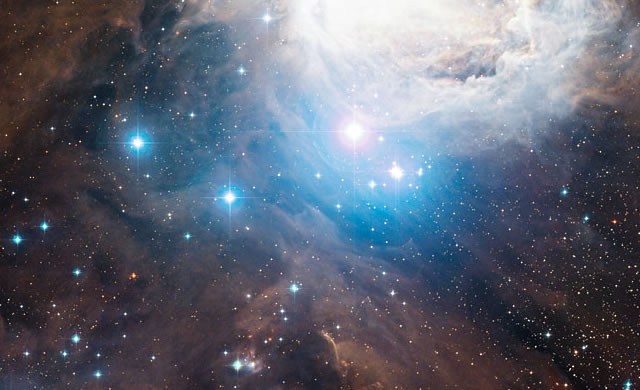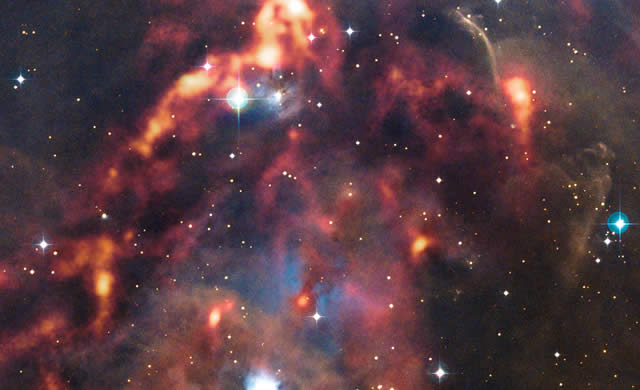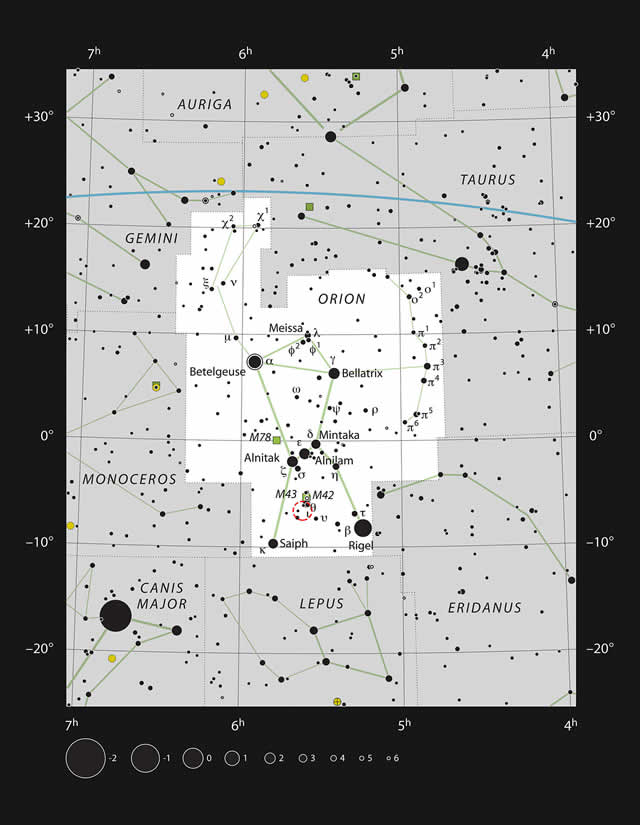
Una nuova immagine dal telescopio APEX (Atacama Pathfinder Experiment) in Cile mostra una splendida vista delle nubi di polvere cosmica nella regione di Orione. Mentre queste dense nubi interstellari appaiono scure e opache nelle osservazioni in luce visibile, la camera LABOCA di APEX osserva il calore emesso dalla polvere e svela i nascondigli in cui si formano nuove stelle. Ma una di queste nubi oscure non è quel che sembra.
Nello spazio, le dense nubi di gas e polvere cosmica costiuiscono il luogo di nascita delle nuove stelle. In luce visibile, questa polvere è scura e opaca e nasconde le stelle dietro di sè così efficacemente che, quando l’astronomo William Herschel ne osservò una nella costellazione dello Scorpione nel 1774, pensò di aver trovato una regione senza stelle e così si dice abbia esclamato: “Qui c’è davvero un buco nel cielo!” Per meglio comprendere la formazione stellare, agli astronomi servono telescopi in grado di osservare a lunghezze d’onda maggiori, come la banda submillimetrica, in cui i grani scuri di polvere emettono invece che assorbire luce. APEX, sulla piana di Chajnantor nelle Ande cilene, è il più grande telescopio ad antenna singola per la banda submillimetrica che opera nell’emisfero australe ed è perciò ideale per gli astronomi che così studiano la nascita delle stelle. Il complesso della nube molecolare di Orione, nella costellazione di Orione, a circa 1500 anni luce dalla Terra, è la regione di formazione stellare massiccia più vicina alla Terra e contiene un tesoro di nebulose brillanti, di nubi oscure e di giovani stelle. La nuova immagine mostra solo una parte di questo vasto complesso in luce visibile, a cui sono sovrapposti i dati di APEX, in brillanti toni arancio, che sembrano incendiare la nube scura. Spesso i grumi più brillanti visti da APEX corrispondono alle macchie più scure in luce visibile – il segno caratteristico di una densa nube di polvere che assorbe la luce visibile ma risplende a lunghezze d’onda submillimetriche, probabilmente una zona di formazione stellare.
Fonte/Leggi tutto → ESO.org

A new image from the Atacama Pathfinder Experiment (APEX) telescope in Chile shows a beautiful view of clouds of cosmic dust in the region of Orion. While these dense interstellar clouds seem dark and obscured in visible-light observations, APEX’s LABOCA camera can detect the heat glow of the dust and reveal the hiding places where new stars are being formed. But one of these dark clouds is not what it seems.
In space, dense clouds of cosmic gas and dust are the birthplaces of new stars. In visible light, this dust is dark and obscuring, hiding the stars behind it. So much so that, when astronomer William Herschel observed one such cloud in the constellation of Scorpius in 1774, he thought it was a region empty of stars and is said to have exclaimed, “Truly there is a hole in the sky here!”. In order to better understand star formation, astronomers need telescopes that can observe at longer wavelengths, such as the submillimetre range, in which the dark dust grains shine rather than absorb light. APEX, on the Chajnantor Plateau in the Chilean Andes, is the largest single-dish submillimetre-wavelength telescope operating in the southern hemisphere, and is ideal for astronomers studying the birth of stars in this way. Located in the constellation of Orion (The Hunter), 1500 light-years away from Earth, the Orion Molecular Cloud Complex is the closest region of massive star formation to Earth, and contains a treasury of bright nebulae, dark clouds and young stars. The new image shows just part of this vast complex in visible light, with the APEX observations overlaid in brilliant orange tones that seem to set the dark clouds on fire. Often, the glowing knots from APEX correspond to darker patches in visible light — the tell-tale sign of a dense cloud of dust that absorbs visible light, but glows at submillimetre wavelengths, and possibly a site of star formation.
Source/Continue reading → ESO.org






















